Symbolism in Romanian folk pottery, as ancient as the Neolithic period, paints the image of an advance culture with a deep understanding of the nature’s laws and human existence.
In art, symbolism uses representative images meant to express a mystical idea, emotions, and states of mind. It was probably through the use of symbols that humankind first addressed the idea of self, the balance between god and evil, the mystery of life and death, above and below.
Yet symbols, evoking such powerful questions and strong emotions, compel to action. Because symbols represent life patters, and thus they justify actions. Actions that, in turn, will create new patterns, and make way to new symbols – or new meanings for old symbols, becoming multi-valent.
This is why understanding the symbols encountered in folk art is both a fascinating and an educational task.
Folk art straddles the traditional and the practical, baring witness to the spirituality and the daily life of a community. The material folk art and its symbols can be admired in seasonal traditions such as sacred egg painting, spiritual painting of Christian icons, daily woodwork, everyday clothes (such as the renowned Romanian ia, but also in decorating folk’s overcoats and hats), traditional masks, and pottery.
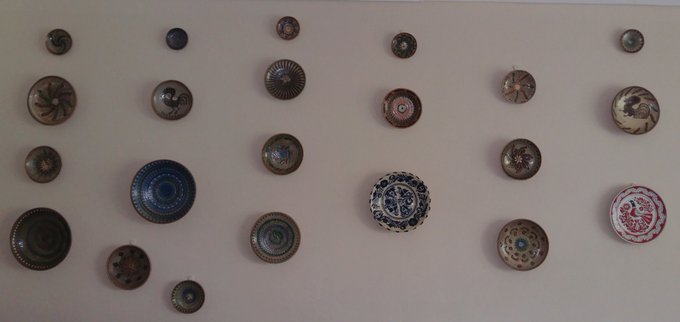
Symbolism in Romanian Folk Pottery
Romanian folk craftsmen have preserved and perfected the ancient technique through which the clay is shaped. Today, Romanian pottery is an art that reflects a purpose (ritualistic, decor, or domestic) and a geographical location (such as Horezu, Corund, Marginea, and Cucuteni).
A brand new pottery created for any memorable event
The shape, colours or motifs used to decorate ceramics vary with the geographical zone and with the object’s destination of use: ritualistic, decor, daily use.
A bowl for the birth of a child, as a new-washbasin, unused and unspoiled was meant for the newborn’s first bath with its meaningful rituals.
Weddings jugs and mugs decorated with joyful, cheerful couples joined in dance, but also horses, snakes, and a hen with chickens.
Mournful dishes for a funeral, meant to be smashed, mimicking the grieve.
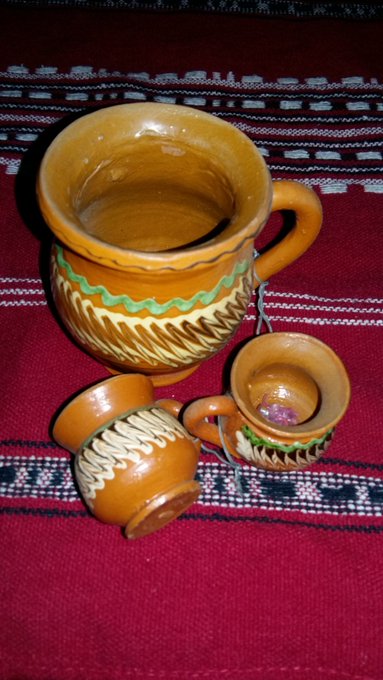
Cheerful folk pottery from Horezu, Vâlcea, Oltenia
Over 2000 years old, the ceramic art of Horezu, Vâlcea, Oltenia, later Wallachia, uses green, blue, brown & red-orange colors.
Paint is poured in the horn of a cow & a thin line is obtained by attaching a geese feather to it. When paint is wet, artist joins the center of a spiral with its edge, as a mark (jirăvirea).

Part of the symbols used are inspired by the local flora and fauna . Beside the double spiral, other symbolical designs for Horezu pottery are the Hurez rooster, the tree of life (connecting earth with heavens), the snaked line (the lost path), concentric circles, the peacock tail, the fir tree (immortality), and the wheat sheaf (prosperity). Among the Christian symbols used to decorate Horezu pottery are: cross, spiral (sun, energy, life cycle, evolution, travels, the passing from night into light, but also femininity, fertility, the whirlwind of life), vine leaf, sun and stars, snake, spring, and the bird.
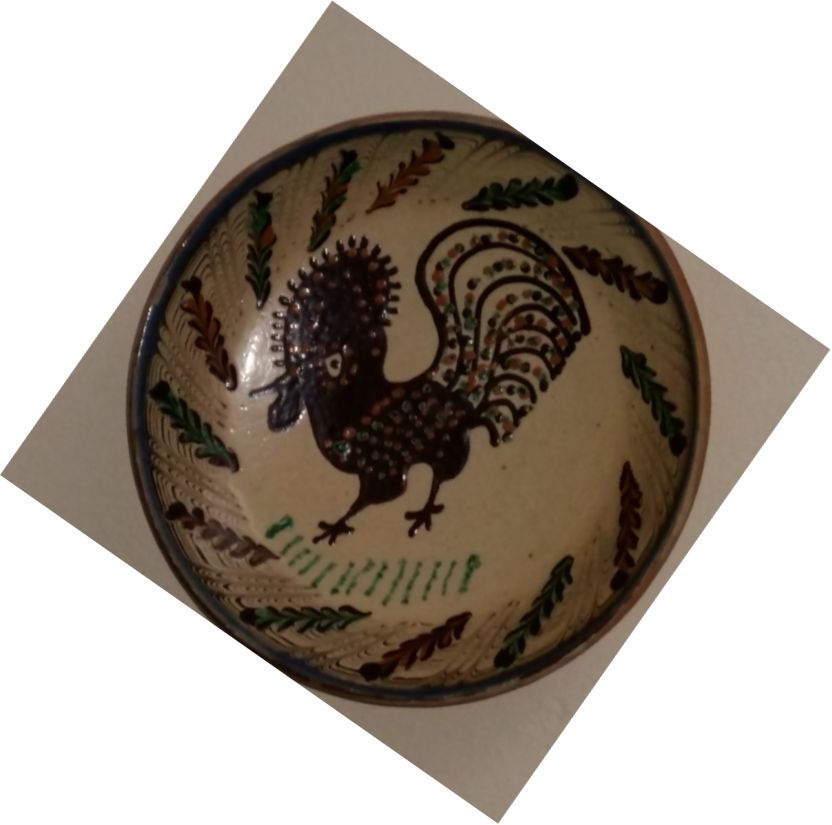
More mundane symbols, but also worthy t mention, are the clover (for luck), rose buds
The Rooster as a symbol in Romanian folk pottery
The Hurez rooster takes focal point in pottery decorations. He is colorful and appears pleased with himself, joyful.
The rooster jumped onto the Horezu folk pottery from the top of the homes from Oltenia county,where he stood proudly as a weather vane, and protector against the unknown, a symbol of light’s triumph against darkness and evil forces.
The rooster is symbol for new beginnings, of light always coming after dark, of sun’s victory against darkness. It stands for courage and strength, the guardian against the unknown, of which it warns the humankind each morning. The rooster also symbolizes rebirth and an immortal spirit.
The rooster’s cheerful song inspires each morning, a constant reminder that life offers new hope each day. And the life moves on, one day at a time.
On the Day of Saint Andrei (30th of November), the song of a rooster calls the Angels and scares away all strigoii (the un-dead).
Romanian Folklore
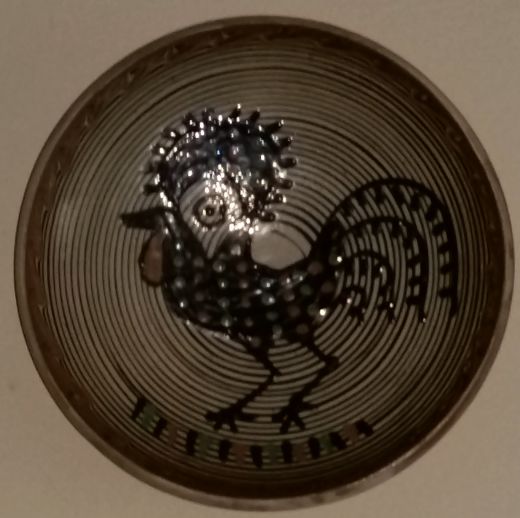
Sometimes more roosters are painted together, in the rooster’s circle (hora).
Since 2012 the Horezu pottery is part of UNESCO Representative List of Intangible Cultural Heritage of Humanity.
Mysterious black pottery from CORUND, Harghita County, Transylvania, and MARGINEA, Suceava, Bucovina County, Moldova
Near the rich salt mines of Harghita and from the land of northern Suceava, at Marginea, the rare and precious, pure, dark-ashen clay is unearthed. Through a secret process of slow baking it turns ebony, mysterious and unique.
Sourced only from Corund, Harghita, Transylvania, the white ceramic is washed with life-giving water and painted with flora, fauna motifs of the area. Specific are the red and blue colors. Pottery is a millennia old family activity: men shape the pots, women paint them.
From my pottery collection:
Symbolical for Corund pottery are the image of the Edelweiss, the tulip, and the wild rooster.
Creating black pottery in Romania
Singular earthenware clay is folded upon the potter’s table, again and again. Worked by strong hands, yet gentle hands, pleated unto itself, wrung like a prayer, kneaded like a holy bread, but harder, then worked again. Held and pressed, rolled into a ball, till it’s compliant enough.
Only then, sat upon the potter’s wheel like on a mythical throne, the negotiation commences. Bribed with drops of clear water, convinced by the artisan’s legendary hands, enchanted by rays of sun from a nearby window, the limp ball of clay rises, then falls, then rises again, till it flourishes into a cup, a bowl, a dish, a bell, a vase.
Three more weeks for it to dry, on a shelf in the potter’s workshop. Then engraved, one by one, some hand-polished with quartz, all clay pottery is slow baked in the potter’s oven under a fire fueled by aromatic fir-trees for up to half a day. The pots remained sealed in the oven for an extra day. This, the magic of the slow baking process and of ash rising from the evergreen logs darkens the pottery to ebony. Finally, the pottery is hand painted, sometimes glazed, like a bride readying herself for her wedding day.
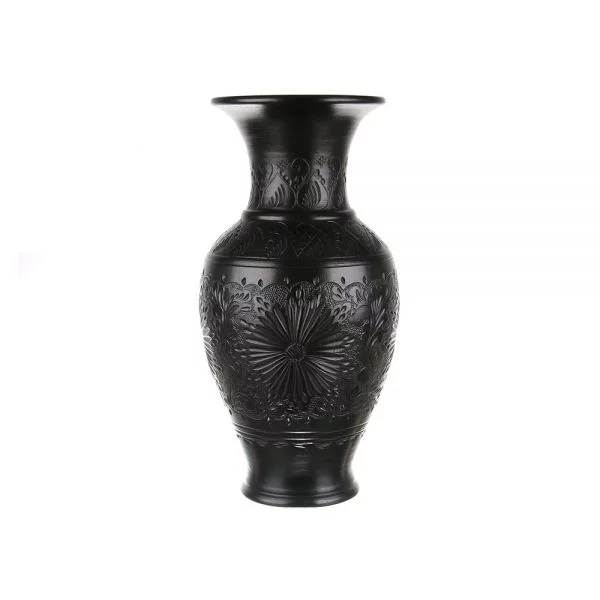
Marginea pottery remembers the Celtic ”La Tène” pottery produced by Geto-Dacians living here over two millennia ago – during the Horodiștea – Florești culture.
What thoughts, what stories, what prayers go through the potter’s mind while his hand work out the magic? Again and again, day in and day out, like his father before him, and his father’s father, till the beginning of time?

The details on a pottery from Marginea are often created with a river stone, picked from the same Sucevita River that gave the clay. They are snakes,spirals, diamonds, or broken lines.
Magical pottery from Cucuteni, Iași, Moldova
As old as the Cucuteni civilization dated 5000 years ago, the most symbolical components of this ancient culture are still visible today in the use of colors white, red, and black, and of zigzag, triangle, diamond, and spiraling, designs, but also anthropomorphic representations of birds and wild life.
The Cucuteni pottery is truly magical as it is made by hand, without the use of a potter’s wheel, but tools of wood, bone, or baked pottery shards. Thus shaped, the pots are bathed in a clay bath, then allowed to take their time drying in the shade. Only then they are painted, then baked.

Symbolical for Cucuteni is the white painted as a base, with a burgundy-red symmetrical design framed by a black line.
Why does a piece of pottery feels so special to hold?
Pottery is far from being cold, it is alive with stories, mystery and history. It is proof of our continuity on this earth, an insurance that spirituality and tradition prevails, that the memory of our ancestors is still alive – and,maybe, that with it a speck of ourselves will leave through.
For more stories about Romania, especially Transylvania:
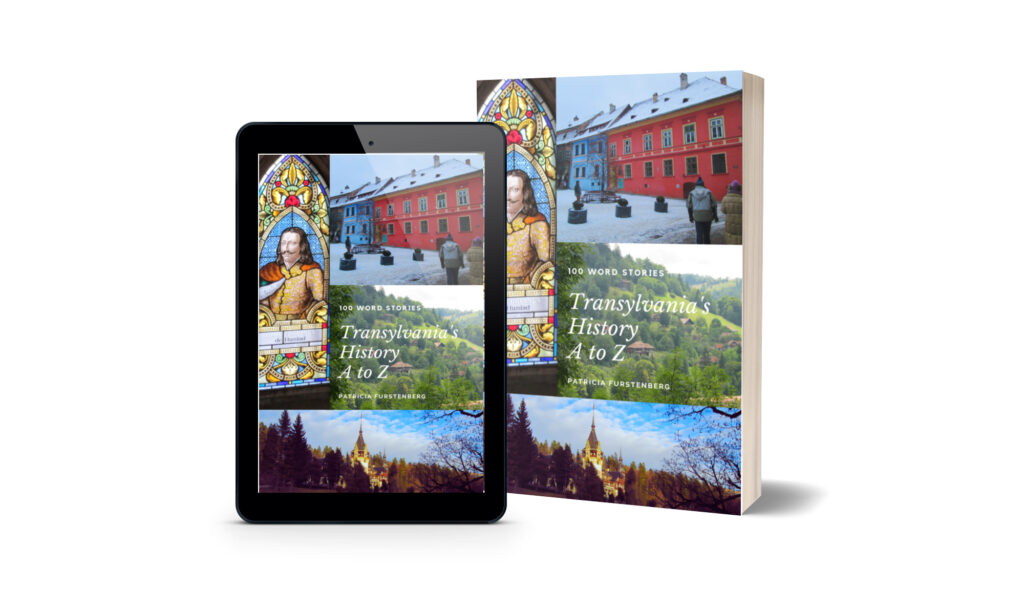
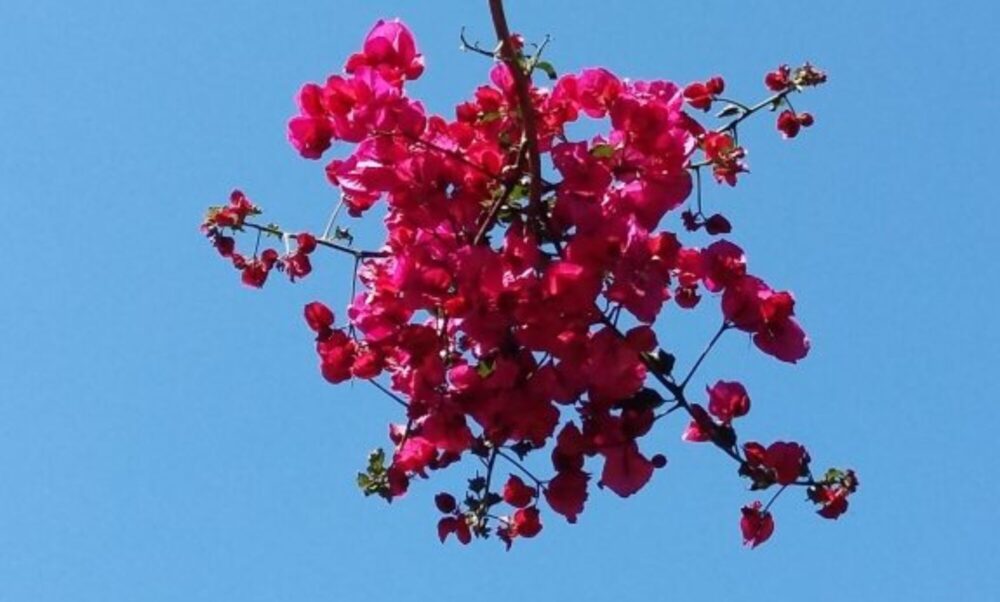


Love the pottery/ art. I also appreciate your post, so different and enjoyable.
Thank you 🙂 Hard to walk past a pottery shop and not slow to a have a peek 😉
I have two examples of black pottery in my house, but I’ve never thought of them as seductively as you do. I guess I’ll appreciate them differently from now on.
You are sweet, Jo 🙂
I think mom has one too. She must have it, because I remember it vividly and wanted to take a picture of it, but it’s not here 😉
Lovely pottery. My favourites are the red bird plate and the black vase? in the following photo.
Thank you so much, Cathy 🙂
They are seductive, aren’t they?
The red bird is perched on the wall in our kitchen here in South Africa 🙂
I had to source a black pot image from some other place as I don’t own one. Yet 😉 So unique.
A joy to look at, with eyes and hands 🙂
Those are such lovely patterns!
Thank you, Vanya! 🙂 So many different design!
Wonderful pottery – that cloth is lovely, too.
The ‘wild rooster’ among tulips looks like a pheasant. What do you think?
Loved this.
I love that cloth too 🙂
I think it’s a mighty rooster 🙂 ready to protect his grounds.
(I can see how his tail makes him look like a pheasant).
Thank you, Michael. I like that cloth too 🙂
Yes, that rooster does look like a pleasant. Maybe he was so excited to sing announce himself, and protect his enclosure. The image of a rooster was used as a weathervane too.
Women would decorate the pottery, still do, children, while the men would labor at the wheel, and wrestle the clay.
Oh, and you meant the red bird on the white plate!
Yes, that does and I think it might be seen as a magic bird. Romanian folklore, like that of other regions, has one.
Some beautiful works of art. I like the rooster and the Marginea pitcher…
Lovely to look at too. So relaxing to imagine the work that went into them.
Thank you for stopping by, Jim 🙂
Yes, a lot of work and care for sure…
Thank you, Jim. I am so glad you think so. There is s much to Romania…
Yes, that pitcher looks cool and inviting, regardless of the liquid it holds. 🙂
And thanks for making us aware of all that Romania offers…
With great pleasure, Jim!
I really enjoyed your gorgeous and encouraging post about symbolism, Patricia! Usually I’am not a rooster lover, but that words here made me laugh:
On the Day of Saint Andrei (30th of November), the song of a rooster calls the Angels and scares away all strigoii (the un-dead).
Many thanks also for your most lovely pictures of ceramics:)
Such a pleasure, Martina, and thank you for sharing your thoughts 🙂
One of our neighbor has a rooster. I can hear it singing as early as 4am. It grows on you, you know? 🙂
:):)Haha!
Celebrating your visit, Martina. And thank you for sharing your thoughts 🙂
One of our neighbors, here in suburban Pretoria, has a rooster. I can hear its song at 4am, so my morning coffee is not so lonely anymore 😉 It sort of grows on you – from a distance.
Very interesting and beautiful imagery. I loved reading the symbolism in this ancient art.
I am glad you enjoyed your visit, Miss Judy 🙂
Thank you, Miss Judy. Always a treat having you here 🙂
Such an interesting post Patricia! Thank you so much for sharing the rich legacy of Rumanian pottery. It´s amazing the symbolism hiden behind these beautiful potery creations. I always loved ancient potery, one of my favorite sections when I visit history and archeology museums.
It makes me so happy to hear this, Blanca. You do have an eye for art 🙂
I wish more could be done to spread the word about the meaning behind ancient symbols. The pottery art in Romania is one of the endangered arts, as less are those willing to learn the craft. It takes years of practice to create a jug, alone at the potter’s wheel, clay all over one’s hands.
Unfortunately, I think the same happens for pottery art all over modern societies. Unfortunately, the pottery craft tradition is being lost.
So true, Blanca. And sad.
Aww, such a great pleasure, Blanca 🙂
It is incredible, isn’t it? 🙂 I enjoyed learning about them too. Sadly, this craft might not last till the next century as less and less young craftsmen learn it.
This was fascinating reading! I do hope that this art doesn’t die out. It is so beautiful. The rooster is my favorite!
Happy to read that you enjoyed it, Susan.
You are spot on, I hope it will still be alive for future generations to enjoy – and learn.
This is really a magical read. There’s so much significance in such handicrafts. From the clay used to the way they are crafted with experienced hands and fired in furnaces. Even the colors and patterns used to decorate them have a meaningful story behind them. The pieces you have shared are truly beautiful. Special heirlooms to be passed on. Thanks for sharing this, Patricia. 🙂
Thank you, Terveen 🙂 So true!
Very beautiful, especially the black pottery!
This is such a fascinating topic!
Thank you.
You are welcome!